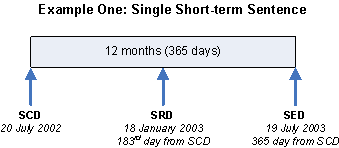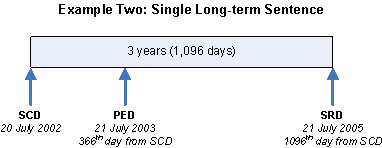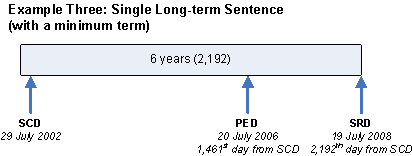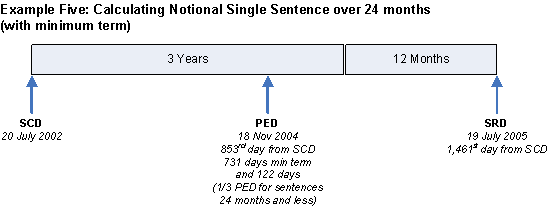I.03.Res.03 Sentence calculations on or after 30 June 2002
This sections sets out how to calculate periods and dates for sentences imposed on or after 30 June 2002.
I.03.R03.01 Manual calculation rules
- For sentences imposed after 30 June 2002, the following must be calculated on all occasions:
- sentence commencement date (SCD)
- dates and periods relating to the prisoner’s eligibility for release:
- parole eligibility date (PED) and the number of days to PED
- statutory release date (SRD) and the number of days to SRD
- sentence expiry date (SED) and the number of days from the SCD to the SED inclusive.
- For sentences imposed on or after 30 June 2002, a day is not added to the release date.
- Individual long-term sentences each have a parole date (at the end of the non-parole period) but an offender will have only one parole eligibility date (PED).
- Individual sentences have a release date but an offender will have one statutory release date (SRD).
- The following calculations exclude pre-sentence detention time unless specifically mentioned.
I.03.R03.02 Parole eligibility date
- Parole eligibility for prisoners sentenced on or after 30 June 2002 is determined by the following length of the sentence:
- Short-term determinate sentence: no eligibility for release on parole.
- Long-term determinate sentence (including a long-term notional single sentence): the non-parole period ends when one-third of the sentence has been served or the minimum term has been completed.
- Life imprisonment: if the prisoner is subject to an order under section 103 of the Sentencing Act 2002, the non-parole period ends on the date on which the offender has served under that sentence the minimum period of imprisonment specified in the order; or in any other case, the date on which the offender has served 10 years under that sentence.
- Preventive detention: the non-parole period ends on the date on which the offender has served under that sentence the minimum period of imprisonment ordered by the Court to be served, which in no case may be less than 5 years.
I.03.R03.03 Calculating a short-term determinate sentence
- Short-term sentences are:
- sentences of imprisonment, including notional single sentences, where the total sentence is 24 months or less or less.
- For calculating dates, the following sentences are similar to short-term sentences:
- sentences where the prisoner is not eligible to be considered for release on parole
- sentences where the prisoner is released after having served half the sentence.
- Calculating sentencing dates for a single short-term sentence:

- Step one: Identify SCD from the Warrant, i.e.20 July 02; this is the first day of the sentence.
- Step two: Calculate in days the total length of the sentence, i.e. 12 months, which equates to 365 days (366 days for leap years).
- Step three: Identify the SED, the 365th day of the sentence from the SCD, i.e. 19 July 2003.
- Step four: Find the SRD for this sentence at half the total sentence length, i.e. 365 divided by 2, which equals 182.5 and is rounded up (part days are always rounded up). It is therefore the 183rd day of the sentence, which is 18 January 2003.
I.03.R03.04 Calculating a single long-term determinate sentence
- Long-term determinate sentence means a sentence of imprisonment that is either a:
- determinate sentence of more than 24 months imposed or after 30 June 2002
- notional single sentence of more than 24 months.
- An offender sentenced to a single long-term sentence is eligible to be considered for release on parole after one third of the sentence has been served, and must be released when the full term of the sentence has been served.

- Step one: Identify the SCD from Warrant, i.e.20 July 2002; this is the first day of the sentence.
- Step two: Calculate in days the total length of the sentence: 3 years x 365 + 1 day for leap year = 1096 days.
- Step three: Find the SED, which is the 1096th day of the sentence from the SCD, i.e. 21 July 2005.
- Step four: Find the PED at one third of the sentence: 1096 days + 3 = 365.33 rounded up to 366. The PED is the 366th day of the sentence, which is 21 July 2003.
- Step five: The SRD for this sentence is the last (1096th) day of the sentence, i.e. 21 July 2005.
I.03.R03.05 Calculating a single long-term sentence with a minimum term
- An offender sentenced to a long-term sentence where a minimum term of imprisonment has been imposed is required to serve the minimum term before being eligible to be considered for release on parole, and must be released when the full term of the sentence has been served.
- In this example the prisoner is sentenced to 6 years imprisonment with a minimum non-parole period of 4 years.

- Step one: Identify the SCD from the Warrant, i.e.20 July 2002.
- Step two: Calculate in days the total length of the sentence i.e. 6 years x 365 + 2 days for leap years = 2,192 days.
- Step three: Find the SED, which is the 2,192nd day of the sentence, i.e. 19 July 2008.
- Step four: Find the PED, which is after the minimum term imposed has elapsed, i.e. 4 years x 365 + 1 for leap year = 1461, i.e. on the 1461st day of the sentence, which is 20 July 2006.
- Step five: Find the SRD, which for this sentence is the last (2192nd) day of the sentence, i.e. 19 July 2008.
I.03.R03.06 Calculating notional single sentence over 24 months
- An offender sentenced to cumulative terms of imprisonment that total more than 24 months is treated in the same manner as an offender serving a long-term sentence. They are eligible to be considered for release on parole after having served one-third of the total sentence, and must be released when the full term of the sentence has been served.
- In this example the prisoner is sentenced to 12 months imprisonment with a cumulative sentence of 12 months and another cumulative sentence of imprisonment of 12 months:

- Step one: Identify the SCD from the Warrant, i.e.20 July 2002.
- Step two: Calculate in days the total length of the sentence i.e. 12 months x 3 = 36 months, or 3 years x 365 + 1 day for leap year = 1096 days.
- Step three: Find the SED, which is the 1096th day of the sentence, i.e. 19 July 2005.
- Step four: Find the PED, which is after one third of the sentence, i.e. 1096 days / 3 = 365.33 rounded up to 366, i.e. on the 366th day of the sentence, which is 21 July 2003
- Step five: Find the SRD, which for this sentence is the last (1,096th) day of the sentence, i.e. 19 July 2005.
I.03.R03.07 Calculating notional single sentence over 24 months with a minimum term
- An offender is sentenced to 3 years imprisonment with an order to serve a minimum of 2 years imprisonment, and a cumulative term of 12 months imprisonment.
- The offender is eligible to be considered for release on parole after having served the minimum period of 2 years imprisonment plus one-third of the 12-month sentence.

- Step one: Identify the SCD from the Warrant, i.e. 20 July 2002.
- Step two: Calculate in days the total length of the sentences, i.e. 3 years x 365 + 1 day for leap year = 1096 days + 12 months (365 days) = 1461 days.
- Step three: Find the SED for the notional sentence, which is the 1461st day of the sentence, i.e. 19 July 2006.
- Step four: Identify the SCD for the 12 month cumulative sentence. This is the day following the SED (19 July 2005) for the first sentence, i.e. 20 July 2005.
-
Step five: Find the PED, which is
- after the minimum term imposed for the 3 year sentence (2 years or 731 days), to which is added
- one third of the 12 month sentence (121.6 rounded up to 122 days) which is a total of 853 days. The PED is the 853rd day of the sentence, which is 18 November 2004.
- Step six: The SRD date for this sentence is after the total length sentence has been served, i.e. 19 July 2005.
I.03.R03.08 Calculating a notional single sentence of 24 months or less
- An offender sentenced to a number of cumulative sentences totalling less than 24 months is released after having served half of the total sentence.
- All prisoners with sentences (including notional sentences) of imprisonment of 24 months or less are not eligible for parole, but for sentence calculation purposes, the parole date is the same as the SRD.
- The following example is for an offender sentenced to cumulative terms of imprisonment totalling 21 months.

- Step one: Identify SCD from the Warrant, i.e.20 July 2002.
- Step two: Calculate in days the total length of the sentences, i.e. 6 months plus 10 months plus 5 months equals 21 months which equates to 640 days.
- Step three: Identify the SED for the notional sentence, which is the 640th day of the sentence i.e. 19 April 2004.
- Step four: Identify the SRD after half the total length of the notional sentence has been served, i.e. half of 640 is 320. The SRD is the 320th day of the sentence, which is 4 June 2003.

